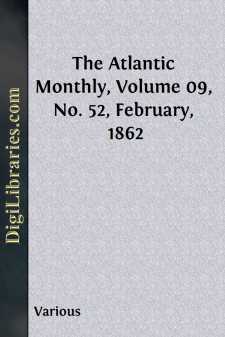Categories
- Antiques & Collectibles 13
- Architecture 36
- Art 48
- Bibles 22
- Biography & Autobiography 813
- Body, Mind & Spirit 142
- Business & Economics 28
- Children's Books 17
- Children's Fiction 14
- Computers 4
- Cooking 94
- Crafts & Hobbies 4
- Drama 346
- Education 46
- Family & Relationships 57
- Fiction 11829
- Games 19
- Gardening 17
- Health & Fitness 34
- History 1377
- House & Home 1
- Humor 147
- Juvenile Fiction 1873
- Juvenile Nonfiction 202
- Language Arts & Disciplines 88
- Law 16
- Literary Collections 686
- Literary Criticism 179
- Mathematics 13
- Medical 41
- Music 40
- Nature 179
- Non-Classifiable 1768
- Performing Arts 7
- Periodicals 1453
- Philosophy 64
- Photography 2
- Poetry 896
- Political Science 203
- Psychology 42
- Reference 154
- Religion 513
- Science 126
- Self-Help 84
- Social Science 81
- Sports & Recreation 34
- Study Aids 3
- Technology & Engineering 59
- Transportation 23
- Travel 463
- True Crime 29
The Atlantic Monthly, Volume 09, No. 52, February, 1862
by: Various
Categories:
Description:
Excerpt
CHAPTER XX
FLORENCE AND HER PROPHET
It was drawing towards evening, as two travellers, approaching Florence from the south, checked their course on the summit of one of the circle of hills which command a view of the city, and seemed to look down upon it with admiration. One of these was our old friend Father Antonio, and the other the Cavalier. The former was mounted on an ambling mule, whose easy pace suited well with his meditative habits; while the other reined in a high-mettled steed, who, though now somewhat jaded under the fatigue of a long journey, showed by a series of little lively motions of his ears and tail, and by pawing the ground impatiently, that he had the inexhaustible stock of spirits which goes with good blood.
"There she lies, my Florence," said the monk, stretching his hands out with enthusiasm. "Is she not indeed a sheltered lily growing fair among the hollows of the mountains? Little she may be, Sir, compared to old Rome; but every inch of her is a gem,—every inch!"
And, in truth, the scene was worthy of the artist's enthusiasm. All the overhanging hills that encircle the city with their silvery olive-gardens and their pearl-white villas were now lighted up with evening glory. The old gray walls of the convents of San Miniato and the Monte Oliveto were touched with yellow; and even the black obelisks of the cypresses in their cemeteries had here and there streaks and dots of gold, fluttering like bright birds among their gloomy branches. The distant snow-peaks of the Apennines, which even in spring long wear their icy mantles, were shimmering and changing like an opal ring with tints of violet, green, blue, and rose, blended in inexpressible softness by that dreamy haze which forms the peculiar feature of Italian skies.
In this loving embrace of mountains lay the city, divided by the Arno as by a line of rosy crystal barred by the graceful arches of its bridges. Amid the crowd of palaces and spires and towers rose central and conspicuous the great Duomo, just crowned with that magnificent dome which was then considered a novelty and a marvel in architecture, and which Michel Angelo looked longingly back upon when he was going to Rome to build that more wondrous orb of Saint Peter's. White and stately by its side shot up the airy shaft of the Campanile; and the violet vapor swathing the whole city in a tender indistinctness, these two striking objects, rising by their magnitude far above it, seemed to stand alone in a sort of airy grandeur.
And now the bells of the churches were sounding the Ave Maria, filling the air with sweet and solemn vibrations, as if angels were passing to and fro overhead, harping as they went; and ever and anon the great bell of the Campanile came pulsing in with a throb of sound of a quality so different that one hushed one's breath to hear. It might be fancied to be the voice of one of those kingly archangels that one sees drawn by the old Florentine religious artists,—a voice grave and unearthly, and with a plaintive undertone of divine mystery....












